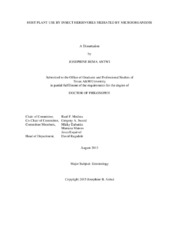| dc.description.abstract | Geographic isolation plays a major role in population divergence, but host-plants can also generate selective forces that drive genetic differentiation. Host-plant associations of insects can also be mediated by their associations with microorganisms, some of which are linked to pest status on crops. However, the ecological and evolutionary roles these microorganisms play in plant-insect interactions are not fully understood, neither are their implications for pest management. My dissertation applied an interdisciplinary approach to explore the potential role of microorganisms in plant-insect interactions. Two important agricultural pests, cotton fleahopper (CFH) (Pseudatomoscelis seriatus), a cotton pest, and sugarcane aphid (Melanaphis sacchari), an invasive pest of sorghum, were used as model organisms in my studies.
Using amplified fragment length polymorphisms (AFLPs) I sampled CFH from 12 host-plants. I found that CFH genotypes are distinct on only 2 out of 12 uncultivated plant species. My results suggest that several uncultivated hosts likely constitute a source of CFH for cotton. To determine whether bacterial symbionts correlated with genetic variation in CFH host-association, I compared bacterial communities within CFH using 454 pyrosequencing of the 16S rRNA gene. There was no correlation between the two. Although CFH is widely distributed across cotton-growing regions in the U.S., it is considered a major cotton pest only in certain regions while in others it is rarely a pest. I compared bacterial communities within CFH using 16S rRNA pyrosequencing to test the potential for bacterial symbionts to influence variation in CFH pest status. Results from this bacterial survey failed to find any correlation between variation in pest status of CFH and bacterial community composition.
I also explored the roles of potentially beneficial symbiotic fungi (i.e., fungal endophytes) in improving plant development and providing resistance against herbivory. Soaking sorghum seeds in liquid suspensions of two fungal endophytes increased seedling height and fresh biomass. Additionally, I detected that endophyte treatment significantly affected the reproduction and behavior of sugarcane aphids, but performance was conditional on the identity of the endophyte and the part of the plant where aphids were located. Overall, findings from my studies improve our understanding of the ecological and evolutionary implications of plant-microbe-insect interactions. | en |


